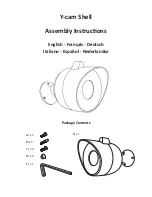
MAN-0093 Rev 0 Oxygen Sensor
June 2008
Net Safety Monitoring Inc.
9
SECTION 2: Installation
2.1 Unpack
Carefully remove all the components from the packaging and check them against the enclosed packing list.
Inspect all components for any obvious damage such as broken or loose parts. If you find any components
missing or damaged, notify the representative or Net Safety Monitoring immediately.
2.2 Mount
The sensor is mounted directly to either transmitter housing or to a separation junction box housing through the
¾” NPT conduit entry. Both the transmitter and separation kit housings have mounting holes to allow mounting
to wall or pole as desired. Mounting kit hardware is required when mounting to a pole.
2.3 Wiring
2.3.1 Field Installation
Warning
Wiring codes and regulations may vary. ATEX requires that supply connection wiring must be
rated at least 5°C above the maximum ambient temperature of 85°C. Wiring must comply with all applicable
regulations relating to the installation of electrical equipment in a hazardous area and is the responsibility of the
installer. If in doubt, consult a qualified official before wiring the system.
Guidelines
When separating the sensor from the transmitter, the use of shielded cable is highly recommended for sensor
wiring to protect against interference caused by extraneous electrical or electromagnetic ‘noise’. To meet IEC
61000-1, IEC 61000-4 EMI and MIL-W16878D Type B/N, Multi-Conductor Braid Shield Cable is
recommended.
In applications where the wiring is installed in conduit, the conduit must not be used for wiring to other
electrical equipment.
The maximum distance between the sensor and transmitter is limited by the resistance of the connecting wiring,
which is a function of the gauge of the wire being used. We limit 2000 ft with 16 AWG wire for
communication.(See Appendix B)
Earth Grounding
An external ground is required. One method is to connect the external ground to the grounding point on the
housing. See Figure 1 for location.
Conduit Entry Protection
The sensors can be mounted directly onto a certified transmitter via the ¾” NPT nipple through which lead
wires are used for connection or separately with the use of certified junction boxes.









































